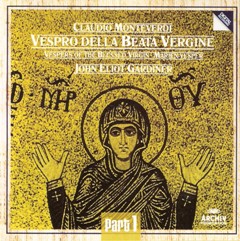111 Years of Deutsche Grammophon - CD 18
111 Years of Deutsche Grammophon - CD 18
Monteverdi: Vespro della Beata Vergine (1610)

Vespro della Beata Vergine 1 Domine ad adiuvandum a 6 [2:10] 2 Dixit Dominus a 6 [7:13] 3 Nigra sum a 1 [3:47] 4 Laudate, pueri Dominum a 8 [5:41] 5 Pulchra es a 2 [3:57] 6 Laetatus sum a 6 [6:31] 7 Duo seraphim a 3 [6:43] 8 Nisi Dominus a 10 [4:36] 9 Audi coelum a 8 [8:35] 10 Lauda Jerusalem a 7 [3:51] Nigel Robson, Mark Tucker, Sandro Naglia, Ann Monoyios, Marinella Pennicchi, Alastair Miles, Jakob Lindberg, David Miller, Christopher Wilson, Marinella Pennicchi, Ann Monoyios English Baroque Soloists, His Majesties Sagbutts and Cornetts, The Monteverdi Choir, John Eliot Gardiner – conductor
Vespro della Beata Vergine 1610 (Vespers for the Blessed Virgin, 1610; SV 206 and 206a) — commonly called Vespers of 1610 — is a musical composition by Claudio Monteverdi. The term "Vespers" (evening prayers) is taken from the Hours of the Divine Office, a set of daily prayers of the Catholic Church which have remained structurally unchanged for 1500 years. In scale, Monteverdi's Vespers was the most ambitious work of religious music before Bach. This 90-minute piece includes soloists, chorus, and orchestra and has both liturgical and extra-liturgical elements.
Vespers is composed around several Biblical texts that are traditionally used as part of the liturgy for several Marian feasts in the Roman Catholic church: the introductory Deus in adjutorium (Psalm 69), five Psalm settings, sacred motets (called “concerti”) between the Psalms, a traditional Hymn, a setting of the Magnificat text and the concluding Benedicamus Domino.
The Vespers is monumental in scale, and requires a choir large enough and skillful enough to cover up to 10 vocal parts in some movements and split into separate choirs in others while accompanying seven different soloists during the course of the piece. Interestingly, solo parts are included for violin and cornett, but the ripieno instrumentation is not specified by Monteverdi. Additionally, he did not specify a set of plainchant antiphons to insert before each psalm and the concluding Magnificat. This allows the performers to tailor the music according to the available instrumental forces and the occasion of the performance (the particular feast day's liturgy would have included suggested antiphons that could be chanted before Monteverdi's psalm settings). Another example of tailoring to the forces available is the fact that the collection includes two versions of the Magnificat, one of which is scored for a smaller group of musicians than the other. Some scholars have argued that this suggests that the Vespers was not intended as a single work, but it is generally performed as such.
Monteverdi's unique approach to each movement of the Vespers earned the work a place in history. The work not only presents intimate, prayerful moments within its monumental scale, but it also incorporates secular music in this decidedly religious performance and its individual movements present an array of musical forms - sonata, motet, hymn, and psalm - without losing focus. The Vespers achieves overall unity by building each movement on the traditional Gregorian plainchant for each text, which becomes a cantus firmus in Monteverdi's setting.








